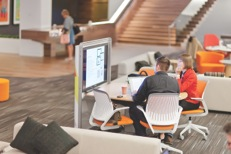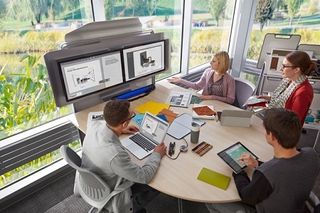Question: how many people does it take before a huddle space isn’t “huddly” enough?
Answer: depends on who you’re talking to.

For Mike Skinner, owner of Audio Video Furniture International, an office furniture manufacturer based in Aurora, Ontario, Canada, huddle spaces are generally single rooms, or large labs with multiple huddle areas––basically, tables equipped with AV technology. “There’s really nothing much in between; it’s either big labs with lots of tables, or it’s single-room applications,” he said.
At Steelcase, an enterprise furniture and technology products manufacturer headquartered in Grand Rapids, Mich., a huddle stops being a huddle once the head count is over three. “When you get over that, when you’re going four-plus, you’re really into a larger space, you’re really connecting people, and I think the user needs change,” said Terry Sullivan, director of integrated technology at the company. “That’s why this definition of the number of people being served physically in the space is a good benchmark to use.”

Sullivan breaks down huddle spaces into three categories: low tech (where the only technology in the room––mobile devices and laptops––is supplied entirely by the huddle participants); medium tech (where the room is outfitted with a display and a connection that enables participants to share content from their BYOD technology); and high tech (spaces that can accommodate videoconferences). He notes that one of the errors organizations often commit, however, is that technology drives huddle space design when it makes more sense to examine what people actually need out of the space, and how they will behave in it.
“If I’m looking for a place [to make] a phone call, [it makes sense to have] real phones in the room that users understand and know how to use,” Sullivan illustrated. “It’s a mistake that we see as more organizations create mobile workplace strategies, and there are times when a landline is going to be best so that you know that your customer can hear you.” Another consideration is creating spaces where people can get away from distractions––a challenge in open offices where even huddle areas may be in plain view.

One common complaint among meeting participants is the amount of tech-related fiddling that is required before meetings can get underway. Biamp Systems, a networked media technology developer headquartered in Beaverton, Ore., has addressed this with the recent release of Devio, the manufacturer’s audio/video-based collaboration tool designed specifically for small gatherings (in this case, roughly four to six people), including huddle spaces. With Devio, users can connect their laptops to the technology in a given space via a USB cable. “These rooms need to be real simple so that end users can just walk in and get going,” said Rob Houston, product manager for unified communications products at Biamp. “We want it to be as easy and as smooth as possible for them to use the audio and video technology that’s been put in that room [so they] can get their work done, get going, and get to arguing or get to brainstorming, or whatever the mode of conversation that’s going to take place in that room is.” If someone is participating from a remote location, they can dial in using their preferred web conferencing platform, just as they would if they were doing a one-on-one conference with someone who was sitting at their desk, and for tech managers, the product features a system administration tool that allows for remote management.
Sally Blank, sales development director for unified communications at Biamp, notes that in smaller spaces, there often isn’t a need to get overly technical. “It seems to me that people try to over-complicate the situation, [and] they think they should have the same technologies that are in their larger rooms––for example, a touch panel and some sort of control,” she said. “That’s perfectly useful and acceptable in the larger rooms, but in the smaller spaces, from our perspective––Devio being an extension of your laptop––it’s using that laptop as the tool that will control the room and control what is taking place in that space.”

Biamp’s history is rooted in audio, so it’s no surprise that Houston underlines the importance of audio quality in a huddle room setting––especially since huddles aren’t like presentation-based meetings. “It’s not turn-based conversation that occurs here, it’s collaboration, which can be messy, and it can involve people speaking over each other,” he said, which can make it difficult for far-end participants to hear what’s going on in the huddle space. Huddles also tend to be active, with people jumping up to highlight something out on the whiteboard, for example, unintentionally turning their backs to the microphone that’s picking up the sound for that remote caller. He notes that in developing Devio, Biamp focused on spaces that would be closed off, partly for this reason.
Black Box, an enterprise technology solutions developer based in Lawrence, Pa., recently introduced its Coalesce wireless BYOD collaboration tool, also designed to simplify collaborative meetings. Coalesce Central, its enterprise management system, allows for remote administration, explains Daniel Vorhes, director of product marketing for technology product solutions at the company. “Whomever is responsible for managing it, they have one dashboard that they can look at and it gives them access to the hub of every one of those spaces,” he said. Black Box’s Control Bridge, he notes, allows for the management of switches. “Between our enterprise management system and the controller, you can [do] central maintenance and management like updates, and with the control [functionality] you have access to control anything with an IP address. So you can find out who’s in the room, who’s using the system, [or] if the room is in use at all.”
Sullivan argues that not all huddle spaces should be created equal. He illustrated his point by describing the space he was in when he spoke with AV Technology via telephone. “[It] has a phone and a small table and a lounge chair that has a fold-up table that can also turn into a foot rest if I want it to, [and] it’s perfect for what I need right now: I have my laptop and I’ve got a good phone for a conversation, and it takes up very small square footage––it’s probably about 48 square feet in total,” he relayed. While this particular space was well suited for Sullivan’s immediate use, or to offer Steelcase employees a location where they can get individual, focused work done, it is not ideal for two to three-person huddles. To Sullivan, this points to a carefully thought out huddle space strategy across the organization: “Thinking about a variety of settings across a floor plan becomes really important.”

That’s not to say that one room shouldn’t be able to accommodate several applications. A huddle that exclusively involves people who are on site requires different technology than one in which there are far-end attendees. A dual purpose space––one that is used for larger-scale meetings and videoconferences as well as one to three-person huddles––will be decked out with more robust systems, but that technology shouldn’t get in the way of those who just need a place for a quick, small, ad hoc meeting. “I think these spaces need to do both––they can’t just be thought of as, ‘well, that’s the videoconferencing room,’ or whatnot,” Sullivan said.
Nor is it practical for organizations to impose rules on how few people can gather in a conference room, for example––especially when in most companies, meeting spaces of all sizes are at a premium, Vorhes noted. “In the era of open work plans, where offices are opening up, and with the price of conference rooms and the lack of them, I don’t think there’s such a thing as, ‘hey, this room is purpose-built for this’ anymore,” he said. “You have to be flexible, and these rooms have to allow for multiple, different purposes. Huddle is one of them.”
Acoustics: They Apply to Huddle Spaces, Too
While video is increasingly important in meetings these days, Rob Houston, product manager for unified communications at Biamp Systems, argues that without solid audio, there’s little chance people will be able to communicate well, basically rendering meetings involving remote participants useless. Technology can help, but if the acoustics are bad, the sound will be, too. “If you case that room in glass, it’s going to be a challenging environment, from an audio perspective, for any audio product to make good sound happen on calls in and out of that room,” he said. An open office layout featuring a glassed-in huddle space may look cool, “but it’s a total nightmare when it comes to the acoustic properties of that room.”
Carolyn Heinze is a regular AV Technology magazine contributor. Follow AV Technology on Twitter: @AVTechnologyMag
GOING MOBILE
"With the rise of remote workers and the expectation from Millennials that workplaces should have modern, consumer-like technologies available, companies increasingly have a mandate to transform to a digital workplace that creates a flexible, productive environment for mobile workers and a physical office environment that will keep employees engaged and productive. According to Gartner, Inc., 46% of companies have Digital Workplace program in place today, and 27% are currently creating a program." —Courtesy of Steelcase










